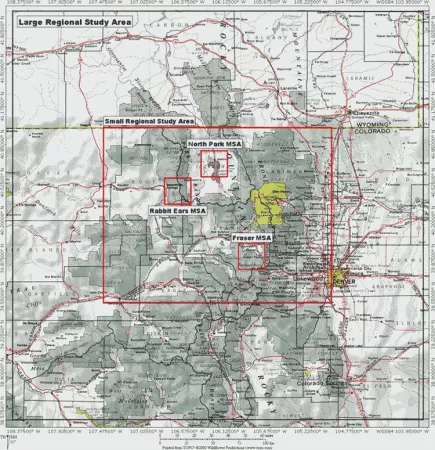
Cold Land Processes Field Experiment (CLPX)
Overview
The NSIDC DAAC CLPX collection includes data products from the NASA-NOAA Cold Land Processes Field Experiment (CLPX) and includes measurements of brightness temperature, albedo, visible and infrared imagery, snow characteristics, vegetation, soil moisture, and meteorology. Conducted primarily between the winter of 2001-2002 and the spring of 2003, CLPX took place in the Central Rocky Mountains of Colorado.
CLPX data products come from models, satellite sensors, airborne surveys, and ground-based measurements that include hundreds of snow pits. The primary goal of CLPX was to identify the best methods of measuring snow’s water content through remote sensing. Researchers identified Colorado’s Rocky Mountains as an ideal experiment location because the area provides a variety of terrains, elevations, and snowpack conditions within a relatively small geographic area. Taking a multi-scale approach to studying snow, researchers used a framework of nested study areas, ranging in size from as large as 160,000 square kilometers to as small as 1 hectare.
To record the likely range of snowpack conditions, CLPX researchers undertook two Intensive Observation Periods (IOPs) in both 2002 and 2003, to coincide with both a dry period (February) and a wet period (March). IOP1 was carried out in February 2002, IOP2 in March 2002, IOP3 in February 2003, and IOP4 in March 2003. To maintain consistency, the IOPs were conducted on the same day-of-year (DOY) schedule. Researchers timed their measurements on the ground to take place while satellites and aircraft observed conditions from above.
Among the satellite sensors watching from the sky was NASA’s Advanced Microwave Scanning Radiometer - Earth Observing System sensor (AMSR-E). Flying onboard NASA’s Aqua satellite, which launched May 4, 2002, AMSR-E began collecting observations before CLPX field researchers started their 2003 season. Among the achievements of CLPX fieldwork was assembling validation data for AMSR-E, and AMSR-E data products are also available from the NSIDC DAAC.
Researchers returned to the Rocky Mountains of the western United States years after CLPX concluded. Using a similar research model to study snow in a variety of landscapes, scientists have since conducted further ground-truthing studies, as part of NASA’s SnowEx mission. Resulting data products are available through the NSIDC DAAC SnowEx collection.
Parameters
Brightness temperature; microwave imagery; visible imagery; albedo; snow: cover, depth, grain size; weather: temperature, humidity, precipitation, winds, clouds; soil moisture; vegetation
Geographic coverage
Colorado Rocky Mountains
Related collection(s)

